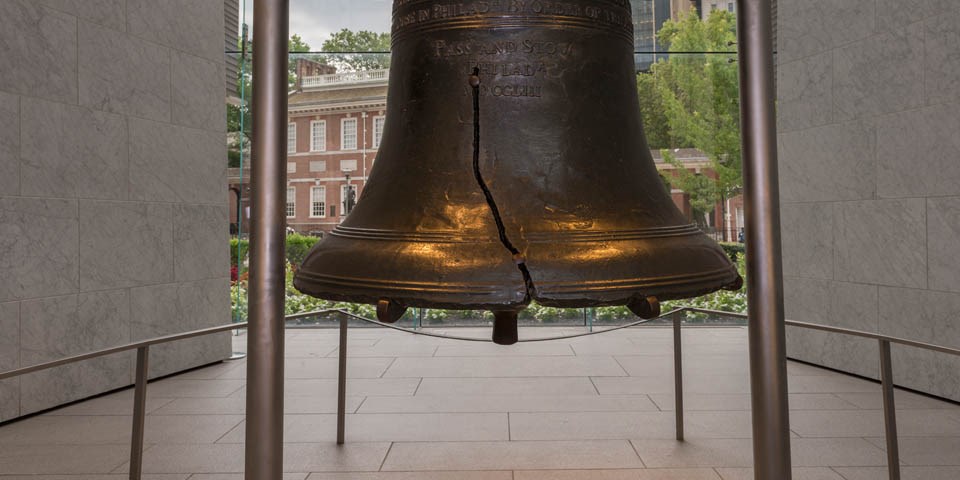Liberty Bell Facts
※ Download: Why does the liberty bell have a crack in it
It gave out clear notes and loud, and appeared to be in excellent condition until noon, when it received a sort of compound fracture in a zig-zag direction through one of its sides which put it completely out of tune and left it a mere wreck of what it was. The Philadelphia Pub … lic Ledger takes up the story in its February 26, 1846 publication:. After the end of World War II, the National Park Service was given custody of the Liberty Bell. This historic bell is located in Philadelphia,.

One theory is the Bell had its first crack in 1752 when it was tested on its arrival in Philadelphia. Washington, DC: Eastern National National Park Service. While the Liberty Bell did not go to the Exposition, a great many Exposition visitors came to visit it, and its image was ubiquitous at the Exposition grounds—myriad souvenirs were sold bearing its image or shape, and state pavilions contained replicas of the bell made of substances ranging from stone to tobacco.

Liberty Bell Facts - Reproduction of a watercolor by Davis Gray of the arrival of the Liberty Bell at Zions Church, in Northampton Towne, later Allentown Pennsylvania on 24 September 1777. Each time, the bell traveled by rail, making a large number of stops along the way so that local people could view it.

For example, how did the Liberty Bell get its famous crack? Did it really ring on July 4, 1776? And where was the Bell hidden from the British? The Liberty Bell pre-dates the Revolution. The Pennsylvania Assembly had the Liberty Bell made in 1751 to mark the 50-year anniversary of William Penn's 1701 Charter of Privileges, which served as Pennsylvania's original Constitution. What is written on the Bell? No one knows today when the Bell was cracked. The crack is a big subject of debate among historians. One theory is the Bell had its first crack in 1752 when it was tested on its arrival in Philadelphia. The Liberty Bell cracked up, literally, in February 1846, when it was rung on the holiday and then stopped ringing because of damage from a major crack. The Liberty Bell rang often during its functional lifetime. Between 1753 and 1846, the Bell tolled for many people and occasions. It rang to mark the signing of the Constitution, and the deaths of Benjamin Franklin, George Washington, Alexander Hamilton and Thomas Jefferson. The bell was originally known as the State House Bell. In the late 1830s, it acquired the name of the Liberty Bell when it became a symbol of the anti-slavery movement. A magazine writer in 1847 made up the story of the bell ringing on the first Independence Day. The bell may also not have rung on July 8, 1776. It is known that bells in the city of Philadelphia were ringing to celebrate the public announcement of the Declaration of Independence. According to , the state house steeple was under repair at the time, making it unlikely for the Liberty Bell to be in use. But with no contemporary accounts, we just don't know. The Bell did go on a Revolutionary road trip. In 1777, the Bell was removed from Philadelphia under armed guard and taken to Allentown, Pa. The fear was the British would melt the Bell and use it to make cannons. It came back to Philadelphia the following year. The Liberty Bell last hit the road in 1915. Back in the day, the Bell went on tour around the United States, but in the days before World War I, it became clear the Bell had condition issues. Today, it resides at , where it is occasionally tapped to mark special occasions. Sign up to receive Constitution Weekly, our email roundup of constitutional news and debate, at.
The was a gift to the people of the United States from the people of Great Britain in 1976. If you are a member, we ask that you confirm your identity by entering in your email. Though attempts were made to repair an existing fracture in the bell for the occasion, and the bell reportedly tolled loud and clear at first, it subsequently cracked beyond repair and had to be taken out of service. While there is no contemporary account of the Liberty Bell ringing, most historians believe it was one of the bells rung. Facts and Figures about the Liberty Bell: Year the bell was originally cast 1752 it was re-cast twice in 1753 Where the Liberty Bell was originally cast Whitechapel Bell Foundry, London, England cast by Thomas Lester The Phildalphia re-casters, 1753 John Pass and John Stow Strike note of the bell E-flat Height of the bell 3 feet Circumference around the lip 12 feet Weight of the bell 2080 pounds just over a ton Size of the crack 24. Although there is no documented proof, it is believed that the Liberty Bell was rung on July 8, 1776, to mark the reading of the Declaration of Independence. Suddenly the bellman's grandson, who was eavesdropping on the doors of Congress, yelled to him, This story so captured the imagination of people throughout the land that the Liberty Bell was forever associated with the Declaration of Independence.



